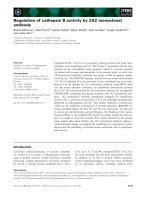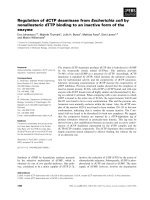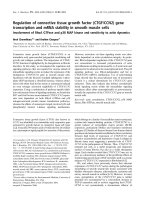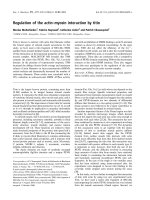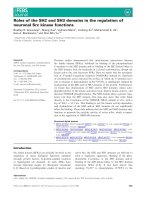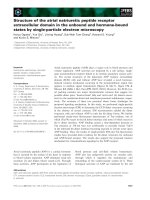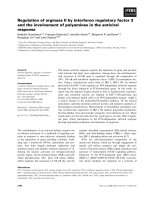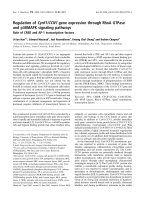Báo cáo khoa học: Regulation of luteinizing hormone receptor mRNA expression by mevalonate kinase – role of the catalytic center in mRNA recognition potx
Bạn đang xem bản rút gọn của tài liệu. Xem và tải ngay bản đầy đủ của tài liệu tại đây (486.37 KB, 11 trang )
Regulation of luteinizing hormone receptor mRNA
expression by mevalonate kinase – role of the catalytic
center in mRNA recognition
Anil K. Nair
1,2
, Matthew A. Young
2,3
and K. M. J. Menon
1,2
1 Department of Obstetrics ⁄ Gynecology, University of Michigan Medical Center, Ann Arbor, MI, USA
2 Department of Biological Chemistry, University of Michigan Medical Center, Ann Arbor, MI, USA
3 Bioinformatics Program, University of Michigan Medical Center, Ann Arbor, MI, USA
The luteinizing hormone receptor (LHR) present on
cell membranes of gonadal tissues belongs to the
family of leucine-rich repeat-containing G-protein-cou-
pled receptors (LGRs) [1,2]. Interaction of luteinizing
hormone (LH) or its placental counterpart, human
chorionic gonadotropin (hCG), with LHR induces
Gs-protein-mediated adenylate cyclase activation,
which leads to an increase in cellular cAMP levels
[1,3,4]. The expression of LHRs varies during the
ovarian cycle, and some of these changes in receptor
Keywords
LH receptor; mevalonate kinase; mRNA
stability; ovary; post-transcriptional
regulation
Correspondence
K. M. J. Menon, 6428 Medical Science 1,
1301 E. Catherine Street, Ann Arbor, MI
48109-0617, USA
Fax: +1 734 936 8617
Tel: +1 734 764 8142
E-mail:
(Received 24 January 2008, revised 2 April
2008, accepted 30 April 2008)
doi:10.1111/j.1742-4658.2008.06490.x
We have shown that hormone-induced downregulation of luteinizing hor-
mone receptor (LHR) in the ovary is post-transcriptionally regulated by an
mRNA binding protein. This protein, later identified as mevalonate kinase
(MVK), binds to the coding region of LHR mRNA, suppresses its transla-
tion, and the resulting ribonucleoprotein complex is targeted for degrada-
tion. Mutagenesis and crystallographic studies of rat MVK have
established Ser146, Glu193, Asp204 and Lys13 as being crucial for its cata-
lytic function. The present study examined the structural aspects of MVK
required for LHR mRNA recognition and translational suppression. Single
MVK mutants (S146A, E193Q, D204N and K13A) were overexpressed in
293T cells. Cytosolic fractions were examined for LHR mRNA binding
activities by RNA electrophoretic mobility shift analysis. All the single
MVK mutants showed decreased LHR mRNA binding activity compared
with the wild-type MVK. Double mutants (S146A & E193Q, E193Q &
D204N and E193Q & K13A) of MVK also showed a significant decrease
in binding to LHR mRNA, suggesting that the residues required for cata-
lytic function are also involved in LHR mRNA recognition. Mutation of
the residues outside the catalytic site (D316A and S314A) did not cause
any change in LHR mRNA binding activity of MVK when compared with
wild-type MVK. To examine the biological effects of these mutants on
LHR mRNA expression, a full-length capped rat LHR mRNA was synthe-
sized and translated using a rabbit reticulocyte lysate system in the pres-
ence or absence of the MVK mutant proteins. The results showed that
mutations of the active site residues of MVK abrogated the inhibitory
effect on LHR mRNA translation. Therefore, these data indicate that an
intact active site of MVK is required for its binding to rat LHR mRNA
and for its translational suppressor function.
Abbreviations
GHMP, galactokinase homoserine kinase mevalonate kinase phosphomevalonate kinase; hCG, human chorionic gonadotropin; IRE, iron
regulatory element; IRP1, iron regulatory protein 1; LBS, LHR mRNA binding protein site; LGR, leucine-rich repeat-containing G-protein-
coupled receptor; LH, luteinizing hormone; LHR, luteinizing hormone receptor; LRBP, LHR mRNA binding protein; MVK, mevalonate kinase.
FEBS Journal 275 (2008) 3397–3407 ª 2008 The Authors Journal compilation ª 2008 FEBS 3397
expression are attributed to post-transcriptional
mechanisms [5–9]. It has been shown that the ligand-
induced downregulation of LHR is paralleled by a
specific, transient disappearance of its mRNA
transcripts [7,10]. Further studies on the mechanism of
rapid degradation of LHR mRNA led to the identifi-
cation of a novel RNA binding protein that mediates
the post-transcriptional regulation of LHR mRNA in
the ovary [10–12]. This protein, initially named LHR
mRNA binding protein (LRBP), was later identified to
be mevalonate kinase (MVK), a critical enzyme
involved in cholesterol biosynthesis [13]. We have
shown that MVK impairs LHR mRNA translation
in vitro, and have established its association with LHR
mRNA during ligand-induced LHR downregulation in
the ovary [14]. Furthermore, we have shown the direct
participation of MVK in ligand-mediated LHR down-
regulation by demonstrating that the suppression of
MVK levels abrogates LHR mRNA downregulation
[15]. Thus, a functional role of MVK in LHR mRNA
expression has been established unequivocally. These
results led us to investigate the structural requirements
of MVK for its ability to bind LHR mRNA and also
for its inhibitory effect on LHR mRNA translation.
MVK catalyzes the transfer of the c-phosphate of
ATP to mevalonate to form mevalonate 5-phosphate,
an intermediate for the formation of isoprene units
required for the synthesis of cholesterol and other
lipid molecules necessary for the post-translational
modifications of proteins [16]. The crystal structure of
rat MVK complexed with ATP-Mg
2+
has been deter-
mined at 2.4 A
˚
resolution [17]. Site-directed mutagen-
esis studies with rat MVK have shown that Ser146,
Glu193, Asp204 and Lys13 are residues at the active
site of MVK necessary for its catalytic function
[17,18]. The active site of MVK has been mapped to
the interphase of the two monomer domains of this
dimeric protein. As our previous studies have shown
that both ATP and mevalonate inhibit the binding of
MVK to LHR mRNA, the present investigation
examines whether the catalytic site of this multifunc-
tional protein participates in LHR mRNA recogni-
tion. Specifically, studies were performed to determine
whether the active site of MVK is required for LHR
mRNA binding and for its role as a translational sup-
pressor of LHR mRNA. The results showed a sub-
stantial decrease in LHR mRNA binding activity
when any of the amino acids at the active site were
mutated. Furthermore, in vitro translation experiments
showed decreased LHR mRNA translation inhibition
by these MVK mutants when compared with wild-
type MVK. Therefore, these data indicate that an
intact active site of MVK is required for its binding
to LHR mRNA and for suppression of its trans-
lation.
Results
LHR mRNA binding activity of rat MVK mutant
proteins
Rat MVK was overexpressed in 293T cells and RNA
electrophoretic mobility shift analysis was performed
with 10 lg of cytosolic S100 protein and [
32
P]-labeled
LHR mRNA binding protein site (LBS) in the pres-
ence of ATP and mevalonate at concentrations of
0.05, 0.5 and 1.0 mm. As shown in Fig. 1, ATP and
No protein
No ATP or Mevalonate
ATP (m
M
)
0.05
B
A
0.5 1 0.05 0.5 1
Mevalonate m
M
)
Relative densitometric units
100
150
200
50
0
I
_
Fig. 1. Effect of ATP and mevalonate on the binding of wild-type
MVK to LBS. (A) RNA mobility shift analysis was performed with
[
32
P]-labeled rat LBS (1.5 · 10
5
c.p.m.) using 5 lg of S100 fraction
prepared from 293T cells 48 h after transfection with pCMV4-
rMVK. ATP and mevalonate were added to the binding reactions in
the concentrations indicated. The autoradiogram shown is repre-
sentative of three independent experiments. (B) The protein bands
were quantified by densitometric scanning followed by analysis
using
NIH IMAGE 1.61 software (mean value ± SE).
Active site of LRBP involved in LHR mRNA recognition A. K. Nair et al.
3398 FEBS Journal 275 (2008) 3397–3407 ª 2008 The Authors Journal compilation ª 2008 FEBS
mevalonate caused a decrease in binding of LHR
mRNA to MVK. The inhibitory effect of mevalonate
was found to be less pronounced when compared with
that of ATP. There was a significant decrease at a con-
centration of ATP or mevalonate of 0.05 mm, but no
complete inhibition at the higher concentrations tested.
This decrease in binding of MVK to LHR mRNA sug-
gests that the ATP ⁄ mevalonate binding region of the
protein may be required for RNA binding. Mutational
and crystallographic studies by others have proposed
that Ser146, Glu193, Asp204 and Lys13 are the impor-
tant amino acids needed for the catalytic activity of
MVK to convert mevalonate to mevalonate 5-phos-
phate.
To examine whether the catalytic site of MVK is
required for RNA binding, we mutated S146 to A,
E193 to Q, D204 to N and K13 to A, individually
and in combination, to generate the following single
and double mutants: S146A, E193Q, D204N and
K13A single mutants, and S146A & E193Q, E193Q
& D204N and E193Q & K13A double mutants. The
mutants were transiently transfected into 293T cells
and the cytosolic proteins (S100) were prepared 48 h
after transfection, as described in Experimental proce-
dures. The expression levels of these mutants and
wild-type MVK were examined by western blot anal-
ysis using MVK antibody. Figure 2A shows the over-
expression of all the single mutants and wild-type
MVK, and Fig. 2B shows the overexpression of all
the double mutants and wild-type MVK. These data
indicate that all the mutants and wild-type MVK
were overexpressed in 293T cells with comparable
expression levels. These S100 preparations were then
used for RNA electrophoretic mobility shift analysis
with [
32
P]-labeled rat LBS as described previously
[19]. Figure 3 shows the RNA binding activity of all
the single mutants and wild-type MVK in the S100
fractions, and Fig. 4 shows the binding activity of
the double mutants and wild-type MVK in the S100
fractions. As reported before, Figs 3 and 4 show
increased LHR mRNA binding activity in the S100
fractions prepared from wild-type MVK compared
with the vector alone (mock). All the single and dou-
ble mutants showed a decrease in RNA binding
activity when compared with wild-type MVK. To
further establish the role of catalytic amino acids in
LHR mRNA binding activity, two amino acid resi-
dues outside the active site region, D316 and S314,
were mutated to Ala, and these mutants were trans-
fected into 293T cells. The LHR mRNA binding
activity of the S100 fractions was then assayed as
described in Experimental procedures. The results in
Fig. 5 show that there was no change in RNA bind-
ing activity of these mutants when compared with
wild-type MVK.
We have shown previously that all the cytidine resi-
dues in LBS are required for MVK binding to LHR
mRNA, as the mutation of cytidine residues in LBS
abolishes its ability to bind to MVK [11]. To verify
that the mutations at the active site of MVK did not
alter its LHR mRNA sequence specificity for binding,
RNA mobility shift analysis was performed using
[
32
P]-labeled LBS with all the double mutants in the
absence and presence of a 10-fold molar excess of
wild-type LBS and mutant LBS in which all the cyti-
dine residues were mutated to uridine. The results
shown in Fig. 6 indicate that all the mutants compete
with wild-type LBS, but not with mutant LBS, similar
to that shown previously for wild-type MVK. This
indicates that the mutations at the active site do not
cause any change in RNA sequence specificity of
A
B
M
wtMVK S146A E193Q D204N K13A
37.1
48.8
64.2 kDa
rMVK
MWt
S146A & E193Q
E193Q & D204N
E193Q & K13A
37.1
48.8 kDa
Fig. 2. (A) Overexpression of single mutants of rat MVK. Human
embryonic kidney (293T) cells were transiently transfected with
pCMV4-rMVK or the four single mutants (S146A, E193Q, D204N
and K13A) of MVK in the pCMV4 vector, and cytoplasmic proteins
(S100) were prepared 48 h after transfection. Western blot analysis
was performed with 30 lg of S100 fractions from vector alone (M),
wild-type MVK (wtMVK) or S146A, E193Q, D204N and K13A
mutant MVKs using MVK antibody. (B) Overexpression of double
mutants of rat MVK. 293T cells were transiently transfected with
pCMV4-rMVK or the three double mutants (S146A & E193Q,
E193Q & D204N and E193Q & K13A) of MVK in the pCMV4 vec-
tor, and cytoplasmic proteins (S100) were prepared 48 h after
transfection. Western blot analysis was performed with 10 lgof
S100 fractions from vector alone (M), wild-type MVK (Wt)
or S146A & E193Q, E193Q & D204N and E193Q & K13A mutant
MVK proteins using MVK antibody. The blots shown are represen-
tative of three experiments with similar results.
A. K. Nair et al. Active site of LRBP involved in LHR mRNA recognition
FEBS Journal 275 (2008) 3397–3407 ª 2008 The Authors Journal compilation ª 2008 FEBS 3399
MVK. The results therefore clearly show that all four
amino acids at the active site of the enzyme required
for catalysis also participate in binding to LHR
mRNA.
Effect of MVK mutant proteins on the
translation of LHR mRNA in vitro
Our previous studies have shown that binding of
MVK to LHR mRNA suppresses the translation of
mRNA in vitro [14]. As the mutation of any of the
four amino acids at the active site of MVK decreases
its binding to LHR mRNA, we examined whether
these mutants were able to reverse the inhibitory effect
of wild-type MVK on LHR mRNA translation. For
this purpose, we employed the in vitro translation
assay using the rabbit reticulocyte lysate system and
subsequent immunoprecipitation of the resulting
FLAG-tagged rat LHR [14]. First, the ability of the
overexpressed wild-type MVK to suppress LHR
mRNA translation was examined as a positive control.
In vitro translation reactions were performed with full-
length capped 3¢-FLAG-tagged LHR mRNA in the
presence and absence of different concentrations of
S100 fraction prepared from cells overexpressing wild-
type MVK. The resulting translation products were
M
No Protein
Wt MVK
Wt MVK
S146A & E193Q
S146A & E193Q
E193Q & D204N
E193Q & D204N
E193Q & K13A
E193Q & K13A
Fig. 4. RNA mobility shift analysis. Gel mobility shift analysis was
performed with [
32
P]-labeled rat LBS (1.5 · 10
5
c.p.m.) using no
protein or 10 lg of S100 fractions from 293T cells transfected with
empty vector (M) or, in duplicate, wild-type rat MVK (WtMVK) or
the three double mutants of rat MVK (S146A & E193Q, E193Q &
D204N and E193Q & K13A) as described in Experimental proce-
dures. The autoradiogram shown is representative of three inde-
pendent experiments.
M
No protein
Wt MVK
S146A
E193Q
D204N
K13A
Fig. 3. RNA mobility shift analysis. Gel mobility shift analysis was
performed with [
32
P]-labeled rat LBS (1.5 · 10
5
c.p.m.) using no
protein or 10 lg of S100 fractions from 293T cells transfected with
empty vector (M), wild-type rat MVK (WtMVK) or the four single
mutants of rat MVK (S146A, E193Q, D204N and K13A), as
described in Experimental procedures. The autoradiogram is repre-
sentative of four independent experiments.
No protein
WT
D316A
S314A
Fig. 5. RNA mobility shift assay. Gel mobility shift analysis was
performed with [
32
P]-labeled rat LBS (1.5 · 10
5
c.p.m.) using no
protein or 10 lg of S100 fractions from 293T cells transfected with
wild-type rat MVK (WT) or the two mutants of rat MVK outside the
active site (D316A and S314A), as described in Experimental proce-
dures. The autoradiogram shown is representative of three inde-
pendent experiments.
Active site of LRBP involved in LHR mRNA recognition A. K. Nair et al.
3400 FEBS Journal 275 (2008) 3397–3407 ª 2008 The Authors Journal compilation ª 2008 FEBS
immunoprecipitated with FLAG antibody, separated
by SDS-PAGE, and then subjected to autoradiography
as described previously [14]. The results (Fig. 7A,B)
showed that the addition of the S100 fraction from the
overexpressed wild-type MVK caused a concentration-
dependent decrease in the translation of LHR mRNA,
similar to that seen with the purified LRBP prepara-
tions [14]. The translation reactions were then per-
formed in the presence of S100 fractions prepared
from cells overexpressing each of the mutant proteins
of MVK. The results in Fig. 8A,B indicate that all the
single and double mutant MVKs showed no substan-
tial inhibition of the translation of LHR mRNA when
compared with wild-type MVK. The data therefore
indicate that the amino acids S146, E193, D204 and
K13, present at the active site of the enzyme and
required for the catalytic activity of MVK, are also
essential for its binding to LHR mRNA and for the
suppression of LHR mRNA translation.
Discussion
We have unraveled a novel post-transcriptional mecha-
nism of LHR regulation in the ovary that involves the
LRBP MVK as a critical trans-acting factor [13,15,19].
We have shown that LRBP binds to the coding region
of LHR mRNA and causes translation inhibition and
subsequent mRNA decay in vitro [10,11,14,19].
The aim of the present study was to identify the
region ⁄ amino acid residues of MVK required for LHR
mRNA recognition. MVK is a member of the galacto-
kinase homoserine kinase mevalonate kinase phospho-
mevalonate kinase (GHMP) kinase superfamily of
enzymes that are known to have a left-handed b–a–b
fold, which is found in other RNA ⁄ DNA binding pro-
teins [20]. Mutagenesis and crystallographic studies of
rat MVK by others have shown that amino acids
Ser146, Glu193, Asp204 and Lys13 are involved in the
phosphorylation of mevalonate to mevalonate 5-phos-
phate [17,18]. As shown in the crystal structure of rat
MVK bound to ATP [17], depicted in Fig. 9A, the
active site of the enzyme is located at the interface of
the N- and C-terminal domains of the monomer. The
adenosine base of ATP is bound at the base of the
left-handed b–a–b fold, where it interacts with a num-
ber of residues in the b–a–b motif. A new crystal
structure of Leishmania major MVK complexed to
mevalonate [21] has allowed us to show that the remain-
der of the active site is formed by two antiparallel
b-sheets linked by a short a-helix, spanning residues
Gly12 to Leu33 (shown in magenta in Fig. 9A). This
motif (containing the conserved ‘motif 1’ [20]) serves
as the base of the binding site for mevalonate and, at
the same time, contributes important catalytic residues,
such as Lys13 (Fig. 9A). The segment b7–loop–a5is
the ATP binding loop with Lys13 in b2, Ser146 in a5,
Wt MVK
C1
10x wtLBS
10x mLBS
S146A&E193Q E193Q&D204N E193Q&K13A
C2 C3 C4
10x wtLBS
10x wtLBS
10x wtLBS
10x mLBS
10x mLBS
10x mLBS
Fig. 6. RNA mobility shift analysis. Competition with wild-type (wtLBS) and mutated (mLBS) LBS. RNA mobility shift analysis was per-
formed with 5 lg of S100 fractions prepared from 293T cells transfected with wild-type rat MVK (WtMVK) or the three double mutants of
rat MVK (S146A & E193Q, E193Q & D204N and E193Q & K13A). Unlabeled wtLBS and mLBS (all C fi U) were added in the binding reac-
tion in molar excess, as described in Experimental procedures. C1, C2, C3 and C4 represent control reactions without unlabeled wtLBS or
mLBS. The autoradiogram is representative of three independent experiments.
A. K. Nair et al. Active site of LRBP involved in LHR mRNA recognition
FEBS Journal 275 (2008) 3397–3407 ª 2008 The Authors Journal compilation ª 2008 FEBS 3401
Glu193 in a6 and Asp204 in a7. During catalysis, Asp
functions as a general base to abstract the proton from
the hydroxyl group of mevalonate [17]. According to
the proposed mechanism, the C5 hydroxyl of mevalo-
nate is in close proximity to both Asp204 and the c-
phosphate of ATP within 4 A
˚
[17]. This is suitable for
donating its proton to Asp and for accepting the phos-
phoryl group from ATP. The side chains of Glu193
and Ser146 help to stabilize the transition state of the
c-phosphate group of ATP by magnesium ion. Lys13
is also found to be within 3–4 A
˚
of the C5 hydroxyl
group of mevalonic acid. This basic residue helps to
lower the pKa value of the C5 hydroxyl group and sta-
bilizes the deprotonated C5 alkoxide group. Thus,
Asp204 and Lys13 are very crucial residues for cataly-
sis that are conserved in other members of the GHMP
family.
To examine the requirement of these amino acids at
the active site of MVK for LHR mRNA binding,
based on our earlier studies, we mutated Ser146 to
Ala, Glu193 to Gln, Asp204 to Asn and Lys13 to Ala.
As illustrated in Fig. 3, RNA electrophoretic mobility
shift analysis using rat LBS as probe showed signifi-
cant decreases in the binding activities of all the single
mutants of MVK proteins overexpressed in 293T cells
when compared with wild-type MVK, indicating that
these amino acids are also essential for LHR mRNA
binding. This was further confirmed by RNA gel shift
analysis, with double mutants of MVK proteins show-
ing decreased LHR mRNA binding activity (Fig. 4).
The role of these amino acids in LHR mRNA binding
C 3 10 20
g
63 kDa
A
B
C 3 10 20 g
0
20
40
60
80
100
120
% of control
Fig. 7. In vitro translation of rat LHR mRNA. Effect of overexpress-
sed wild-type rat MVK. (A) FLAG-tagged rat LHR mRNA (200 ng)
was in vitro translated using 0.6
M Bq of [
35
S]methionine in the
presence of increasing concentrations of S100 protein (3–20 lg)
from pCMV4-rMVK-transfected 293T cells overexpressing wild-type
rat MVK. The translated LHR proteins were immunoprecipitated
and SDS-PAGE was performed and processed to develop the auto-
radiogram. The control (C) experiment was performed in the
absence of S100 protein. The autoradiogram is representative of
three independent experiments. (B) The protein bands were quanti-
fied by densitometric scanning followed by analysis using
NIH IMAGE
1.61 software, and graphed as a percentage of the control (mean
value ± SE).
A
B
Control
Control
wt mvk
wt mvk
S146A
S146A
E193Q
E193Q
D204N
D204N
63 kDa
K13A
K13A
S146A & E193Q
S146A & E193Q
E193Q & D204N
E193Q & D204N
E193Q & K13A
E193Q & K13A
63 kDa
Fig. 8. In vitro translation of rat LHR mRNA. Effect of mutant rat
MVK proteins. FLAG-tagged rat LHR mRNA (200 ng) was in vitro
translated using 0.6
M Bq of [
35
S]methionine in the presence of
10 lg of S100 protein from 293T cells transfected with wild-type
MVK (wtmvk) and all the single (A) and double (B) mutants of rat
MVK. All were performed in duplicate. The translated LHR proteins
were immunoprecipitated and SDS-PAGE was performed and pro-
cessed to develop the autoradiogram. Controls were performed
with no S100 proteins. The autoradiogram is representative of
three independent experiments.
Active site of LRBP involved in LHR mRNA recognition A. K. Nair et al.
3402 FEBS Journal 275 (2008) 3397–3407 ª 2008 The Authors Journal compilation ª 2008 FEBS
activity was further established by mutations outside
the catalytic region. These mutants did not produce
any change in the RNA binding activity of MVK
(Fig. 5). As a decrease in the RNA binding activity of
MVK was observed when the amino acids at the active
site were mutated, we examined the LHR mRNA
translational suppressor function of these mutated
MVK proteins using a rabbit reticulocyte lysate sys-
tem. A substantial reversal of translational suppression
of LHR mRNA by all the MVK mutant proteins was
observed (Fig. 8A,B). This indicates that these amino
acids at the catalytic site of MVK are crucial for its
function as a translational suppressor of LHR mRNA.
A number of metabolic enzymes have been charac-
terized as RNA regulatory proteins [22]. One of the
well-characterized enzymes performing two entirely dif-
ferent functions is the cytosolic protein aconitase
[23,24]. Aconitase has been identified as iron regula-
tory protein 1 (IRP1), which binds to the iron regula-
tory elements (IREs) present in the 3¢-untranslated
regions of mRNAs [23–26]. Recently, its crystal struc-
ture as a cytosolic aconitase [27] and its complex with
frog ferritin IRE-RNA [28] have been solved. These
studies found extensive overlap between the enzyme
active site and RNA binding site of IRP1. Many of
the amino acids at the active site of aconitase were
found to serve both catalytic and RNA binding func-
tions, thus showing the functional plasticity of these
amino acids. In its IRP1 form, domains 3 and 4
undergo a substantial shift in their relative positions to
the central core formed by domains 1 and 2, to open
up a hydrophilic cavity for IRE between the core and
domain 3. This shows the conformational flexibility of
this protein to perform an entirely different function.
Similarly MVK acts as a dual function protein, pos-
sessing both catalytic function and LHR mRNA bind-
ing activity. This RNA binding activity of MVK leads
to translational suppression and triggers LHR mRNA
degradation in vitro [14,19]. This is in agreement with
other studies, in which it has been reported that trans-
lational arrest ⁄ inhibition or aberrant termination can
lead to the degradation of eukaryotic mRNA [29–32].
In the present study, we have demonstrated that the
amino acids Ser146, Glu193, Asp204 and Lys13 at the
active site of MVK, required for catalysis, are also
required for LHR mRNA binding. This dual function
ATP
MEV
E193
S146
D204
K13
A
B
C
Fig. 9. (A) Structure of rat MVK (MVK) bound to ATP-Mg
2+
[17] with a model of mevalonate based on the crystal structure of mevalonate
bound to Leishmania major MVK [21]. Residues comprising the left-handed b–a–b motif are colored cyan. The b–a–b motif is disrupted by a
50 residue insert that is colored green. ATP and mevalonate are shown in stick representation. Residues forming the base of the mevalonate
binding pocket, Gly12 to Leu33, are colored magenta. The side chains of Asp204 interacting with Lys33 are indicated, as are the side chains
of Glu193 and Ser146 interacting with the Mg
2+
ion (green sphere). The model was constructed by superimposing the crystal structure of
L. major MVK bound to mevalonate onto the structure of rat MVK bound to ATP-Mg
2+
. Mevalonate from the L. major structure was then
extracted onto the rat MVK complex. (B, C) Structures of two other left-handed b–a–b motifs interacting with RNA are shown for S5 and S9
ribosomal RNA proteins both bound to the 30S ribosome [33].
A. K. Nair et al. Active site of LRBP involved in LHR mRNA recognition
FEBS Journal 275 (2008) 3397–3407 ª 2008 The Authors Journal compilation ª 2008 FEBS 3403
nature is very similar to the functional flexibility of
some of the amino acids identified at the active site of
the cytosolic enzyme aconitase. These data therefore
indicate that an intact active site of MVK is required
for its binding to rat LHR mRNA and for its transla-
tional suppressor function. Although b–a–b motifs are
found in a number of known RNA binding proteins,
the exact details of the mode of interaction between
RNA and this motif still remain somewhat unclear.
Inspection of two other left-handed b–a–b motif-con-
taining proteins cocrystallized with RNA as part of the
30S ribosome particle (shown in Fig. 9B,C) has failed
to reveal a conserved mode of interaction between the
protein motif and RNA [33]. The diverse locations of
RNA relative to the motif make any proposed struc-
tural argument about the mode of RNA binding spec-
ulative at this point, but we believe that our data
suggest that some kind of structural linkage between
substrate and RNA binding is a reasonable hypothesis.
Two structural scenarios that explain the present muta-
genesis data are as follows: (a) the RNA binding site
overlaps with the site of ATP binding and may exploit
common side chain interactions; or (b) the conforma-
tions of residues involved in RNA binding may be
directly or indirectly coupled to the binding of ATP
and mevalonate.
Once LHR mRNA becomes an untranslatable
mRNA–protein complex by binding to MVK, it may be
recruited to the RNA degradation pathway with the
help of other interacting partners of MVK that are asso-
ciated with translation and⁄ or mRNA decay machinery.
Experimental procedures
Chemicals
The QuickChange 11 XL Site-Directed Mutagenesis Kit
was purchased from Stratagene (La Jolla, CA, USA).
[a-
32
P]UTP was obtained from Perkin Elmer Life Sciences
(Boston, MA, USA) and Redivue l-[
35
S]methionine (in vitro
translation grade) was purchased from Amersham
Biosciences (Arlington Heights, NJ, USA). mMessage
mMachine T7 Ultra and MAXIscript Kits were products of
Ambion (Austin, TX, USA). EDTA-free protease inhibitor
mixture tablets and Quick spin columns (G-50 Sephadex)
for radiolabeled RNA purification were obtained from
Roche Molecular Biochemicals (Indianapolis, IN, USA).
RNasin and Flexi Rabbit Reticulocyte Lysate System were
purchased from Promega (Madison, WI, USA). Centriplus
YM-10, Centricon YM-10 and Microcon YM-10 were
products of Millipore Corporation (Bedford, MA, USA).
Anti-FLAG M2-Agarose affinity gel was purchased from
Sigma (St Louis, MO, USA). Bicinchoninic acid reagent
was from Pierce (Rockford, IL, USA). Enlightning (rapid
autoradiography enhancer) reagent was a product of NEN
Life Science Products, Inc. (Boston, MA, USA). DL-Meva-
lonic acid lactone and ATP (Mg salt) were purchased from
Sigma. Mevalonic acid lactone was converted to potassium
mevalonate by incubation with a 5% molar excess of KOH
at 38 °C for 1 h, adjusted to pH 7.8 and stored at )20 °C.
Construction of MVK cDNA mutants
The mutants of rat wild-type MVK in pCMV4 vector were
prepared using the QuickChange 11 XL Site-Directed Muta-
genesis Kit from Stratagene. The mutagenic sense (S) prim-
ers used were as follows: S146A, 5¢-GCGGGCTTGGGCT
CCGCTGCAGCCTACTCGGTG-3¢; E193Q, 5¢ -GCCTAC
GAGGGGCAGAGAGTGATCCATGGG-3¢; D204N, 5¢-C
CCTCTGGCGTGAACAATTCCGTCAGCACC-3¢; K13A,
5¢-GTGTCTGCTCCAGGGGCAGTCATTCTCCATGG-3¢;
D316A, 5¢-CACGCCTCCCTGGCCCAGCTCTGTCAG-3¢;
S314A, 5¢-GTGGGCCAC GCCGCCCTG GACCAGCT G-3¢.
The single mutants were then subsequently employed for the
synthesis of S146A & E193Q, E193Q & D204N and E193Q
& K13A double mutants using the appropriate mutagenic
primers as shown above. The mutations were verified at the
DNA Sequencing Core at the University of Michigan
Medical School.
In vitro transcription
The cDNA used to generate rat LBS was chemically syn-
thesized and contained the T7 RNA polymerase promoter
sequence at the 5¢ end. [a-
32
P]-labeled LBS was in vitro
transcribed from cDNA template using an Ambion in vitro
transcription kit. The full-length capped and FLAG-tagged
rat LHR mRNA was synthesized using an mMessage
mMachine T7 Ultra Kit. The wild-type and mutant rat
LBSs were synthesized using the MAXIscript Kit. The
radiolabeled LHR mRNA was prepared using 2.2 m Bq of
[a-
32
P]UTP in the reaction mixture. After transcription, the
RNAs were treated with RNAse-free DNase 1 and
extracted with nuclease-free water-saturated phenol–chloro-
form–isoamyl alcohol (50 : 49 : 1). Unincorporated nucleo-
tides were removed using Quick spin columns (G-50
Sephadex). RNA was precipitated with an equal volume of
isopropyl alcohol at )20 °C. The precipitated RNA was
washed three times with 75% ethanol, air-dried and
dissolved in nuclease-free water. Both radiolabeled and
unlabeled RNAs were quantified spectrophotometrically at
260 nm.
In vitro translation
In vitro translation reactions (reaction volume, 25 lL) were
performed using the Flexi Rabbit Reticulocyte Lysate
Active site of LRBP involved in LHR mRNA recognition A. K. Nair et al.
3404 FEBS Journal 275 (2008) 3397–3407 ª 2008 The Authors Journal compilation ª 2008 FEBS
System, as described by the manufacturer. Proteins synthe-
sized in vitro were labeled with [
35
S]methionine and sepa-
rated by 10% SDS-PAGE (BioRad mini gel) according to
the method of Laemmli. The gel was fixed in 40% metha-
nol (v ⁄ v) and 10% acetic acid (v ⁄ v) for 20 min, and then
incubated in Enlightning reagent for another 30 min. The
gel was then dried under vacuum for 20 min at 80 °C and
exposed to X-ray film for autoradigraphy.
Immunoprecipitation
FLAG-tagged in vitro-translated rat LHR was immunopre-
cipitated using anti-FLAG M2-Agarose affinity gel; 25 lL
of the in vitro-translated reaction mixture was diluted to
500 lL with dilution buffer (50 mm Tris ⁄ HCl, pH 7.4,
150 mm NaCl, 1 mm EDTA and 1% Triton X-100). Anti-
FLAG M2-Agarose affinity gel was washed three times
with wash buffer (50 m m Tris ⁄ HCl, pH 7.4, 150 mm NaCl),
added to the diluted translation reaction mixture (40 lL gel
suspension per 500 lL diluted translation reaction mixture)
and incubated overnight in an end-over-end shaker at 4 °C.
The sample was centrifuged for 5 s at 10 600 g at room
temperature and the supernatant was removed. The beads
were washed three times with wash buffer and 30 lLof2·
SDS-PAGE sample buffer was added. The beads with sam-
ple buffer were heated at 65° C for 20 min, centrifuged at
10 600 g for 5–10 s and the supernatant was collected. The
supernatant was then applied to 10% SDS-PAGE.
RNA electrophoretic mobility shift analysis
RNA electrophoretic mobility shift analysis was performed
as described previously [10]. Briefly, 10 lg of cytosolic S100
protein sample was incubated with (1–2) · 10
5
c.p.m. of
[a-
32
P]UTP-labeled rat LBS. Binding reactions were carried
out in buffer A (10 mm Hepes, pH 7.9, 0.5 mm MgCl
2
,
50 lm EDTA, 5 mm dithiothreitol and 10% glycerol)
(pH 7.5) containing 50 mm KCl and protease inhibitor mix-
ture. Incubations were performed in the presence of 5 lgof
tRNA and 40 U of RNasin (Promega) at 30 °C for 30 min.
Unprotected radiolabeled RNA was degraded by the addi-
tion of 25 U of RNase T1 at 37 °C for 30 min. Samples
were then incubated with heparin (final concentration,
5mgÆmL
–1
) on ice for 10 min to reduce nonspecific binding.
The RNA–protein complexes were resolved by 5% native
polyacrylamide (70 : 1) gel electrophoresis at 4 °C. The gel
was then dried and exposed to Kodak X-Omat AR film for
visualization by autoradiography.
Preparation of cytosolic proteins (S100 fraction)
Transiently transfected 293T cells were detached from
culture dishes with NaCl ⁄ P
i
–EDTA and pelleted using
500 g for 5 min. The cell pellets were homogenized at 4 °C
in buffer A containing 50 mm KCl and EDTA-free protease
inhibitor mixture. Homogenates were centrifuged at
105 000 g for 90 min at 4 °C, the supernatants (S100) were
collected and total protein was quantified using a bicinch-
oninic acid Protein Assay Kit (Pierce).
Overexpression of rat MVK in 293T cells
Human embryonic kidney cells (293T cells) were transiently
transfected with rat MVK cDNA cloned into pCMV4 vec-
tor using Fugene 6 reagent, as described by the manufac-
turer (Roche Molecular Biochemicals). Cells were collected
48 h post-transfection, and the cytosolic proteins (S100)
were prepared as described previously [13]. The S100 frac-
tions were analyzed for MVK by western blot analysis.
Western blot analysis
Proteins were separated by 10% SDS-PAGE and trans-
ferred to nitrocellulose membrane using 25 mm Tris buffer
containing 192 mm glycine and 20% methanol (pH 8.3)
for 1 h at 4 °C. Rat MVK was detected using a rabbit
polyclonal anti-N-terminal rat MVK IgG preparation
(40 lgÆmL
)1
), followed by a polyclonal donkey anti-rabbit
IgG conjugated to horseradish peroxidase (1 : 10 000) as a
second antibody. The presence of immune complexes was
detected by chemiluminescence using an ECL kit (Amer-
sham Biosciences).
Acknowledgements
The authors would like to thank Helle Peegel, Pradeep
Kayampilly and Palaniappan Murugesan for critical
reading of the manuscript. This work was supported
by National Institutes of Health (NIH) Grant R37
HD 06656.
References
1 Ascoli M, Fanelli F & Segaloff DL (2002) The lutro-
pin ⁄ choriogonadotropin receptor, a 2002 perspective.
Endocr Rev 23, 141–174.
2 Menon KM, Munshi UM, Clouser CL & Nair AK
(2004) Regulation of luteinizing hormone ⁄ human chori-
onic gonadotropin receptor expression: a perspective.
Biol Reprod 70, 861–866.
3 Dufau ML (1998) The luteinizing hormone receptor.
Annu Rev Physiol 60, 461–496.
4 Menon KMJ & Gunaga KP (1974) Role of cyclic AMP
in reproductive processes. Fertil Steril 25, 732–750.
5 Hoffman YM, Peegel H, Sprock MJ, Zhang QY &
Menon KMJ (1991) Evidence that human chorionic
gonadotropin ⁄ luteinizing hormone receptor down-regu-
A. K. Nair et al. Active site of LRBP involved in LHR mRNA recognition
FEBS Journal 275 (2008) 3397–3407 ª 2008 The Authors Journal compilation ª 2008 FEBS 3405
lation involves decreased levels of receptor messenger
ribonucleic acid. Endocrinology 128, 388–393.
6 LaPolt PS, Oikawa M, Jia XC, Dargan C & Hsueh AJ
(1990) Gonadotropin-induced up- and down-regulation
of rat ovarian LH receptor message levels during follic-
ular growth, ovulation and luteinization. Endocrinology
126, 3277–3279.
7 Lu DL, Peegel H, Mosier SM & Menon KMJ (1993)
Loss of lutropin ⁄ human choriogonadotropin receptor
messenger ribonucleic acid during ligand-induced down-
regulation occurs post transcriptionally. Endocrinology
132, 235–240.
8 Peegel H, Randolph J Jr, Midgley AR & Menon KMJ
(1994) In situ hybridization of luteinizing hormone ⁄
human chorionic gonadotropin receptor messenger ribo-
nucleic acid during hormone-induced down-regulation
and the subsequent recovery in rat corpus luteum.
Endocrinology 135, 1044–1051.
9 Segaloff DL, Wang HY & Richards JS (1990) Hor-
monal regulation of luteinizing hormone ⁄ chorionic gon-
adotropin receptor mRNA in rat ovarian cells during
follicular development and luteinization. Mol Endocrinol
4, 1856–1865.
10 Kash JC & Menon KMJ (1998) Identification of a hor-
monally regulated luteinizing hormone ⁄ human chori-
onic gonadotropin receptor mRNA binding protein.
Increased mRNA binding during receptor down-regula-
tion. J Biol Chem 273, 10658–10664.
11 Kash JC & Menon KM (1999) Sequence-specific bind-
ing of a hormonally regulated mRNA binding protein
to cytidine-rich sequences in the lutropin receptor open
reading frame. Biochemistry 38, 16889–16897.
12 Nair AK, Peegel H & Menon KMJ (2006) The role of
luteinizing hormone ⁄ human chorionic gonadotropin
receptor-specific mRNA binding protein in regulating
receptor expression in human ovarian granulosa cells.
J Clin Endocrinol Metab 91, 2239–2243.
13 Nair AK & Menon KMJ (2004) Isolation and charac-
terization of a novel trans-factor for luteinizing hor-
mone receptor mRNA from ovary. J Biol Chem 279,
14937–14944.
14 Nair AK & Menon KM (2005) Regulation of luteiniz-
ing hormone receptor expression: evidence of transla-
tional suppression in vitro by a hormonally regulated
mRNA-binding protein and its endogenous association
with luteinizing hormone receptor mRNA in the ovary.
J Biol Chem 280, 42809–42816.
15 Wang L, Nair AK & Menon KMJ (2007) Ribonucleic
acid binding protein-mediated regulation of luteinizing
hormone receptor expression in granulosa cells: rela-
tionship to sterol metabolism. Mol Endocrinol 21, 2233–
2241.
16 Buhaescu I & Izzedine H (2007) Mevalonate pathway: a
review of clinical and therapeutical implications. Clin
Biochem 40, 575–584.
17 Fu Z, Wang M, Potter D, Miziorko HM & Kim JJ
(2002) The structure of a binary complex between a
mammalian mevalonate kinase and ATP: insights into
the reaction mechanism and human inherited disease.
J Biol Chem 277, 18134–18142.
18 Cho YK, Rios SE, Kim JJ & Miziorko HM (2001)
Investigation of invariant serine ⁄ threonine residues in
mevalonate kinase. Tests of the functional significance
of a proposed substrate binding motif and a site impli-
cated in human inherited disease. J Biol Chem 276,
12573–12578.
19 Nair AK, Kash JC, Peegel H & Menon KMJ (2002)
Post-transcriptional regulation of luteinizing
hormone receptor mRNA in the ovary by a novel
mRNA-binding protein. J Biol Chem 277, 21468–
21473.
20 Zhou T, Daugherty M, Grishin NV, Osterman AL &
Zhang H (2000) Structure and mechanism of homoser-
ine kinase: prototype for the GHMP kinase superfam-
ily. Structure
8, 1247–1257.
21 Sgraja T, Smith TK & Hunter WN (2007) Structure,
substrate recognition and reactivity of Leishmania major
mevalonate kinase. BMC Struct Biol 7, 20.
22 Ciesla J (2006) Metabolic enzymes that bind RNA: yet
another level of cellular regulatory network? Acta
Biochim Pol 53, 11–32.
23 Klausner RD & Rouault TA (1993) A double life: cyto-
solic aconitase as a regulatory RNA binding protein.
Mol Biol Cell 4, 1–5.
24 Klausner RD, Rouault TA & Harford JB (1993) Regu-
lating the fate of mRNA: the control of cellular iron
metabolism. Cell 72, 19–28.
25 Beinert H, Holm RH & Munck E (1997) Iron–sulfur
clusters: nature’s modular, multipurpose structures.
Science 277, 653–659.
26 Hentze MW & Kuhn LC (1996) Molecular control of
vertebrate iron metabolism: mRNA-based regula-
tory circuits operated by iron, nitric oxide, and
oxidative stress. Proc Natl Acad Sci USA 93, 8175–
8182.
27 Dupuy J, Volbeda A, Carpentier P, Darnault C, Moulis
JM & Fontecilla-Camps JC (2006) Crystal structure of
human iron regulatory protein 1 as cytosolic aconitase.
Structure 14, 129–139.
28 Walden WE, Selezneva AI, Dupuy J, Volbeda A, Fon-
tecilla-Camps JC, Theil EC & Volz K (2006) Structure
of dual function iron regulatory protein 1 complexed
with ferritin IRE-RNA. Science 314, 1903–1908.
29 Jacobson A & Peltz SW (1996) Interrelationships of the
pathways of mRNA decay and translation in eukaryotic
cells. Annu Rev Biochem 65, 693–739.
30 Pachter JS, Yen TJ & Cleveland DW (1987) Autoregu-
lation of tubulin expression is achieved through specific
degradation of polysomal tubulin mRNAs. Cell 51,
283–292.
Active site of LRBP involved in LHR mRNA recognition A. K. Nair et al.
3406 FEBS Journal 275 (2008) 3397–3407 ª 2008 The Authors Journal compilation ª 2008 FEBS
31 Ross J (1995) mRNA stability in mammalian cells.
Microbiol Rev 59, 423–450.
32 Blume JE & Shapiro DJ (1989) Ribosome loading, but
not protein synthesis, is required for estrogen stabiliza-
tion of Xenopus laevis vitellogenin mRNA. Nucleic
Acids Res 17, 9003–9014.
33 Carter AP, Clemons WM, Brodersen DE, Morgan-
Warren RJ, Wimberly BT & Ramakrishnan V (2000)
Functional insights from the structure of the 30S ribo-
somal subunit and its interactions with antibiotics.
Nature 407, 340–348.
A. K. Nair et al. Active site of LRBP involved in LHR mRNA recognition
FEBS Journal 275 (2008) 3397–3407 ª 2008 The Authors Journal compilation ª 2008 FEBS 3407


